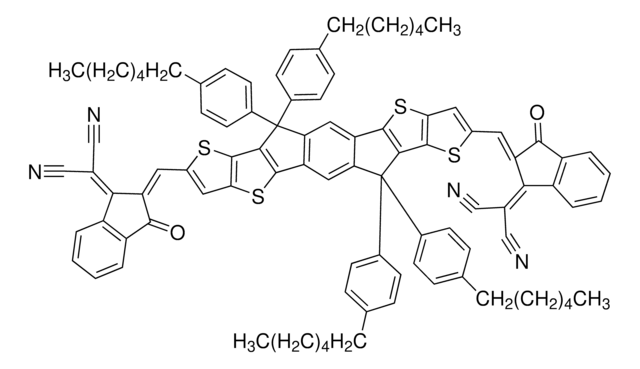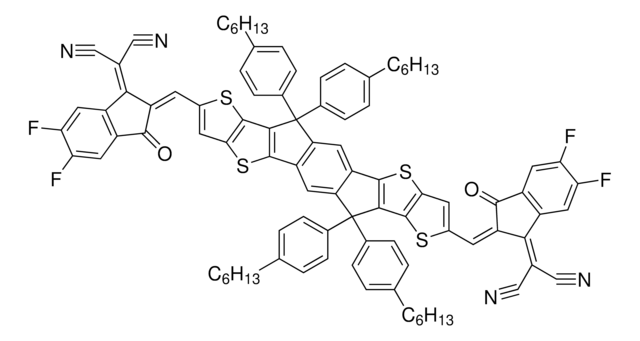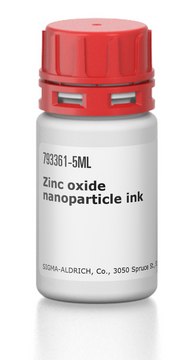推荐产品
描述
Band gap: 1.9 eV
表单
particles
分子量
Mw 80,000-200,000 g/mol by GPC
颜色
Fine
溶解性
chlorobenzene: soluble
chloroform: soluble
dichlorobenzene: soluble
轨道能量
HOMO -5.5 eV
LUMO -3.6 eV
PDI
2‑4
应用
聚合物供体材料
LUMO=−3.6 eV
HOMO=−5.5 eV
OPV设备性能:
PBDB-T-2F:ITIC-F (1:1 w/w)
Voc= 0.84V
Jsc= 22.2 mA/cm2
FF= 0.725
PCE=13.5%
PBDB-T-2F(或PM6)是一种包含氟化噻吩基苯并二噻吩(BDT-2F)的宽带隙聚合物供体(N型半导体),用于高性能聚合物太阳能电池(PSC)。PBDB-T-2F具有高结晶性和强烈的π-π堆积排列,有利于电荷载流子的传输,从而抑制了器件中的重组。据报道,基于PBDBT-2F的PSC具有厚度和面积不敏感的性能,并且是大规模滚动制造高效聚合物太阳能电池的有前途的候选者。
例如,最近,新的研究表明,基于pBDB-T-2F:IT-4F(Sigma Aldrich目录编号901423)的PSC产生了令人印象深刻的PCE,为13.5%,这是由于供体和受体上氟化的协同效应,这是迄今为止PSC文献中记录的最高值之一[1]。基于PBDB-T-2F:IT-4F的PSC相对于有效性也显示出良好的存储,热和照明稳定性。在广泛的膜面积和厚度范围内,高效性保持在>11%。当与基于硒代苯[3,2-b]噻吩的窄带隙非富勒烯受体配对时,获得了令人印象深刻的13.3%的有效性,具有厚度不敏感的特征。
以前也有报道,PBDB-T-2F与窄带隙小分子受体2,2′-((2Z,2′Z)-((4,4,9,9-四己基-4,9-二氢-s-茚并[1,2-b:5,6-b′]二噻吩-2,7-二基)双(亚甲基))双(3-氧代-2,3-二氢-1H-茚-2,1-二亚基))二丙二腈(IDIC),铸态薄膜(未经额外处理)显示出11.9%的出色功率转换有效性(PCE),是铸态聚合物太阳能电池的记录值。此外,基于PBdB-T-2F:IDIC的器件的性能对有源层厚度(≅95-255 nm)和器件面积(0.20-0.81 cm2)不敏感,因此是未来卷到卷的有希望的候选者批量制造和高效PSC的实际应用。
PBDB-T-2F在300-685 nm的短波长范围内具有很强的吸收,具有1.80 eV的大带隙,与ITIC(1.55 eV)互补,有助于实现PSC中的高短路电流(Jsc)。此外,PBDB-T-2F显示出−5.50 eV的深HOMO水平,强结晶性和堆积的主要面,这有助于在PSC中实现高开路电压(Voc)并填充因子(FF)。
储存分类代码
11 - Combustible Solids
WGK
WGK 3
闪点(°F)
Not applicable
闪点(°C)
Not applicable
商品
To achieve net-zero emissions by 2050, renewable power contributions must triple. Photovoltaic stations provide vital utility power, achieved primarily through third- and fourth-generation technology. Promising trends include recycling and revolutionary, ultra-lightweight, flexible, and printable solar cells.
Professor Chen (Nankai University, China) and his team explain the strategies behind their recent record-breaking organic solar cells, reaching a power conversion efficiency of 17.3%.
我们的科学家团队拥有各种研究领域经验,包括生命科学、材料科学、化学合成、色谱、分析及许多其他领域.
联系技术服务部门
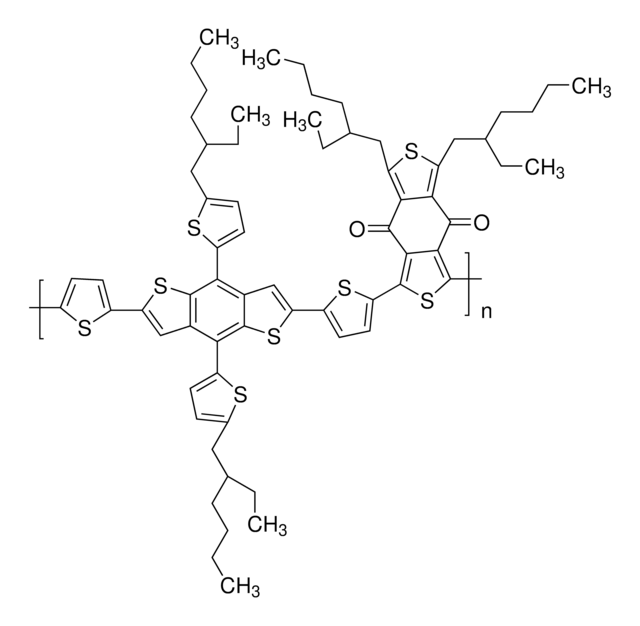
![聚 [2,6′]-4,8-二(5-乙基己基噻吩)苯并 [1,2-b;3,3-b] 二噻吩 ] {3-氟-2 [(2-乙基己基)羰基] 噻吩 [3,4-b] 噻吩二基 })](/deepweb/assets/sigmaaldrich/product/structures/187/203/ca94f947-403e-4832-8656-fc754d4148f5/640/ca94f947-403e-4832-8656-fc754d4148f5.png)
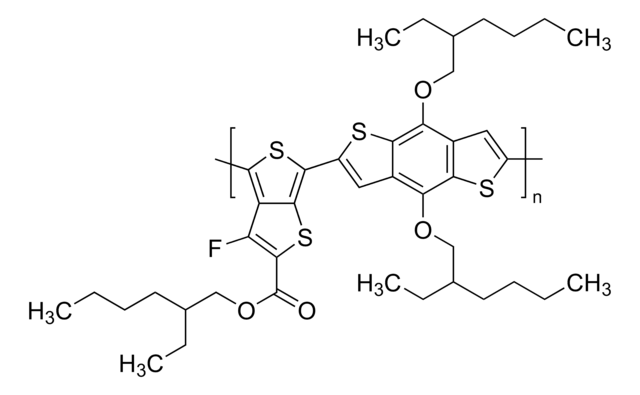
![[6,6]-苯基 C71 丁酸甲酯,异构体混合物 99%](/deepweb/assets/sigmaaldrich/product/structures/716/624/9fb9f2f0-ae99-429f-8d3a-b12267976a4d/640/9fb9f2f0-ae99-429f-8d3a-b12267976a4d.png)
